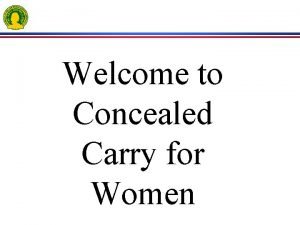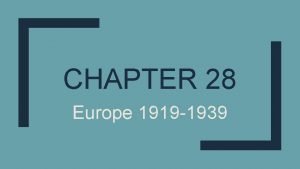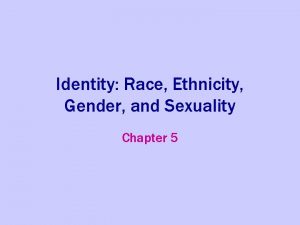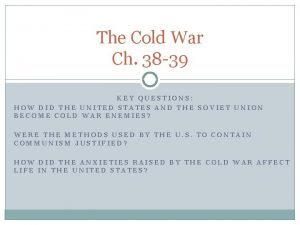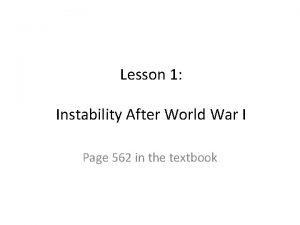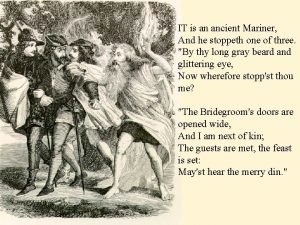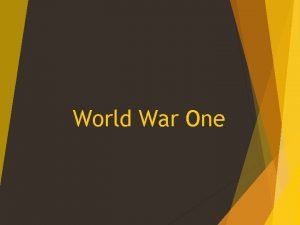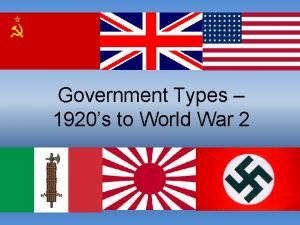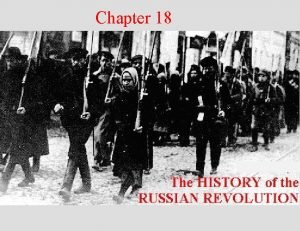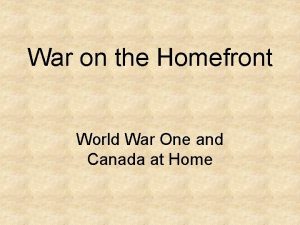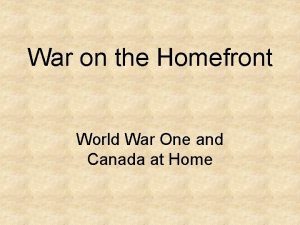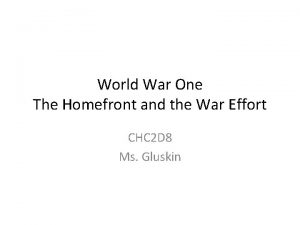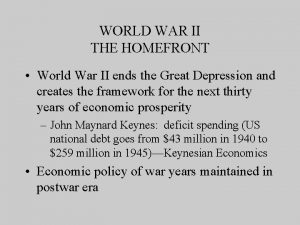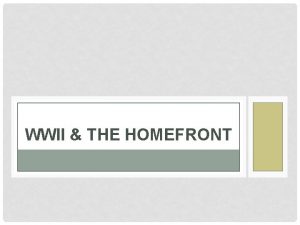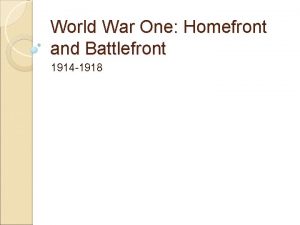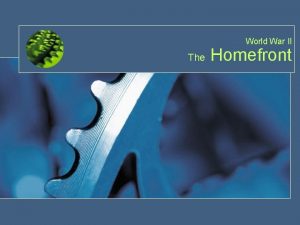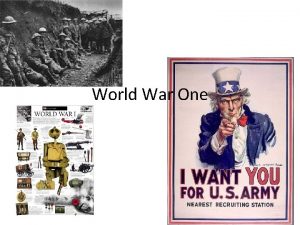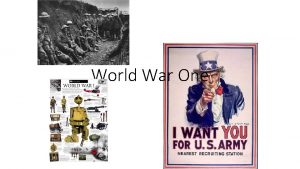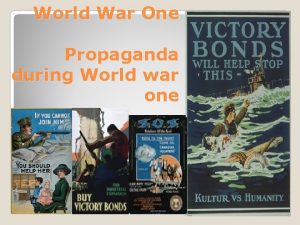World War One War on the Homefront After














- Slides: 14

World War One

War on the Homefront • After declaring war in 1917, the Government used Progressive ideas to mobilize the people and the economy. • The Government created the “War Industries Board” to coordinate the production of war materials. • The WIB determined what was produced, what factories produced, and allocated raw materials.

• The Government also created the “National War Labor Board” to mobilize the workforce. • The NWLB made sure that wages were good, hours were fair, and that unions never went on strike. • The NWLB brought in Women, Mexican workers from Mexico, and African Americans from the south to work in the factories. NWLB Propaganda poster

Propaganda • Propaganda played a large role in mobilizing workers and civilians for the war effort. • The Government also asked citizens to ration food, conserve fuels, and buy war bonds for the war effort • Citizens were pushed to plant “victory gardens” and to have Wheat-less Mondays and Meatless Tuesdays to conserve for the troops. • Citizens were also asked to conserve fuels by having Heatless Mondays and early bedtimes to conserve electricity.


Recruits • Many looked forward to going to war… why? – – – Patriotism Adventure Boredom Pay Career To stay out of jail v. It was a decision most would regret.

Building America’s Military • When the US entered the war, it had less than 300, 000 soldiers/sailors. • With the need for more soldiers, the US started the “Selective service” or the Draft. • The Draft filled the ranks of the Army and Navy with 2. 8 million men. Another 2 million volunteered. • 400, 000 African American soldiers were drafted (42, 000 saw combat).

Combat in WWI • After the major battles of Tannenberg, Marne, and Ypres, the war turned into a stalemate. • Troops settled into mile-long trenches, separated by a “no man’s land”. • “No man’s land” was a barren, tree-less landscape, pockmarked with craters from artillery. • These trenches soon became mud filled, blood soaked, rat infested areas. This is where the soldiers lived for months at a time.

Trench warfare


New Technology • The world saw new technology used for the first time in WWI. v. Submarines v. Airplanes (for attack, not recon) v. Tanks v. Poison Gas v. Machine Guns v. Zeppelins v. Long range artillery

The War Draws to an End • With the stalemate on the Western Front lasting many months, the Americans showed up just in time to change the tide of war. YORK • General Pershing and his troops launched attacks all over the Western Front, pushing the Germans out of their trenches. RICKENBACKER • Alvin York and Eddie Rickenbacker became American heroes for their roles in the Battle of the Argonne Forest.

The War Ends • After revolutions in Germany and A-H, the Central powers signed and armistice to end the war. • January, 1919: 27 countries agreed to officially end the war with the “Treaty of Versailles”. • The treaty called for Germany to give back all territory it took, to take the blame for starting the war, and to pay millions ($$$) in war reparations (money paid to fix war damage). • The treaty also dissolved Austria-Hungary and replaced it with Austria as a new nation. • Both Nations were also forced to give up all weapons and capped their armies at 30, 000 men (for defense only).

Reactions to the Treaty… • The Central powers were bitter because they were forced to take the blame for the war. • Many German soldiers were upset because they felt betrayed by their government. • The German Government was unhappy because they owed war reparations. • The Allies liked the Treaty because it kept Germany weak and it dissolved A-H. • President Wilson liked the treaty because it included parts of his “Fourteen points”. • The new nations of Yugoslavia, Czechoslovakia, Poland, and Hungary were happy to recognized.
 Gungoddess holster
Gungoddess holster Homefront wsgc
Homefront wsgc After me after me after me
After me after me after me John 14:1-3
John 14:1-3 Chapter 28 lesson 1 instability after world war i
Chapter 28 lesson 1 instability after world war i Migration after world war 2
Migration after world war 2 Cold war map
Cold war map Instability after world war i
Instability after world war i One after one by the star dogged moon
One after one by the star dogged moon It is an ancient mariner and he stoppeth one of three
It is an ancient mariner and he stoppeth one of three Cold war jeopardy review game
Cold war jeopardy review game One world factors
One world factors World war one
World war one World war one
World war one World war one
World war one
